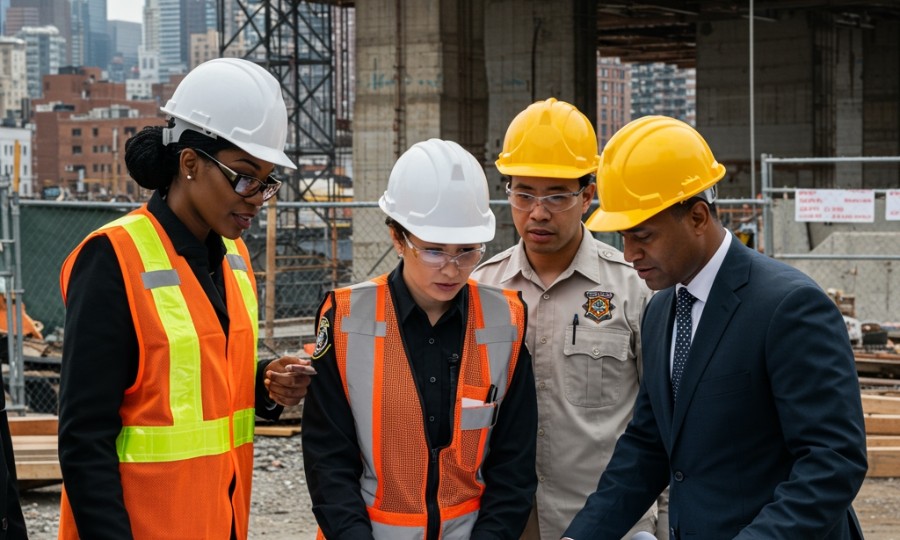
Brooklyn’s skyline is a testament to relentless ambition and hard work, constantly evolving with new structures that shape our city’s future. But beneath the rising steel and gleaming facades, a darker reality often unfolds: serious accidents and, heartbreakingly, fatalities on construction sites. Doesn’t it make you stop and wonder, at what cost does this progress truly come? We’re talking about real people, real families, and an impact that reverberates through our communities.
It’s easy to see construction as just another industry, but it’s one with inherent dangers that demand unwavering vigilance. When we hear about a worker fatality or a major incident, it’s not just a statistic; it’s a profound loss. These events force us to confront uncomfortable truths about safety protocols, regulatory oversight, and the sometimes immense pressure to complete projects quickly. Our goal here isn’t to point fingers but to understand the landscape, acknowledge the human cost, and explore how we can collectively push for a safer future for every person who helps build our vibrant borough.
The Sobering Reality of Brooklyn’s Construction Landscape
Recent reports paint a concerning picture across Brooklyn. We’ve seen a disturbing number of incidents, from falls that prove fatal to workers being struck by equipment or collapsing structures. These aren’t isolated anomalies; they often highlight systemic issues that demand our immediate attention. For instance, just recently, we saw reports of a worker tragically falling from an unsecured scaffold on a residential project. It’s a stark reminder that falls remain one of the leading causes of construction fatalities, a fact repeatedly highlighted by the Occupational Safety and Health Administration (OSHA) in their annual ‘Fatal Four’ statistics. (And honestly, it’s a completely preventable tragedy in most cases.)
The NYC Department of Buildings (DOB) is often on the scene, conducting thorough investigations into these incidents. Their findings frequently point to common culprits: inadequate fall protection, improper use of heavy machinery, or insufficient training for specialized tasks. You might wonder, with all the regulations in place, how do these things still happen? It’s a complex interplay of factors, from tight deadlines pushing companies to cut corners to a lack of proper communication on site. We’re not just talking about minor injuries; we’re discussing life-altering events that leave families devastated and communities shaken.
Unpacking the "Why": Common Causes and Regulatory Vigilance
So, what’s really driving these heartbreaking incidents? Generally speaking, the root causes are often predictable, yet stubbornly persistent. Beyond falls, another persistent issue we’re seeing is ‘struck-by’ incidents. Think about it: a crane malfunction, unsecured materials swinging unexpectedly, or even a vehicle backing up without proper spotters. These aren’t just unfortunate accidents; they’re frequently symptomatic of systemic failures in safety protocols, a lack of clear communication, or insufficient hazard awareness training. OSHA data consistently shows that being struck by an object is a major contributor to construction-related deaths, and it’s something we’re seeing far too often in Brooklyn.
Regulatory bodies like the NYC DOB and OSHA aren’t just issuing fines after the fact; they’re actively working to enforce compliance and conduct proactive inspections. However, the sheer volume of construction projects in Brooklyn means they can’t be everywhere all the time. This puts an even greater onus on construction companies and site managers to prioritize safety from the ground up, not just as a compliance checkbox. We’ve heard too many stories where a simple safety measure, like properly shoring a trench or ensuring workers wear appropriate personal protective equipment (PPE), could have prevented a catastrophe. Are we truly doing enough to protect the men and women who build our city, day in and day out?
The Human Cost: Beyond the Headlines
When a major incident occurs, the immediate focus is often on the investigation, the legal ramifications, and the logistical challenges. But for those directly affected, the impact is far more profound and enduring. We know this feels overwhelming, maybe even a little helpless, when you read about these tragedies. Imagine a trench collapse – a sudden, terrifying event that traps workers. The immediate investigation focuses on soil stability, shoring techniques, or lack thereof, trying to understand the engineering failure. But what about the family left behind? The partner, the children, the parents who’ve lost a loved one? The long-term psychological toll on those who witnessed it? It’s a ripple effect that extends far beyond the immediate incident, touching co-workers, friends, and the broader community.
You might be thinking these are just statistics, numbers on a report, but they represent real lives, real families impacted forever. The economic consequences, too, are significant – lost wages, medical bills, and the cost of emotional support services can be astronomical. I believe that understanding this human dimension is critical; it moves us beyond abstract policy discussions and grounds us in the very real stakes involved. Every fatality is a son, a daughter, a parent, a friend whose absence leaves an irreplaceable void. Can we truly put a price on a human life?
Preventing Future Tragedies: Proactive Steps and Worker Rights
So, what can be done to prevent future tragedies on Brooklyn construction sites? Here’s the thing: preventing these incidents isn’t just about stricter laws, though those are important; it’s about fostering a pervasive culture of safety. Employers have a fundamental legal and moral obligation to provide a safe working environment. This includes not only supplying proper equipment and comprehensive training but also ensuring diligent supervision and actively encouraging workers to report unsafe conditions without fear of reprisal. The NYC DOB, for example, has been pushing for enhanced site safety plans and more rigorous training for supervisors, which is a step in the right direction.
For workers, you’ve got rights. You shouldn’t ever feel pressured to work in unsafe conditions. Knowing who to report to – whether it’s your supervisor, a union representative, or directly to OSHA or the NYC DOB – is crucial. OSHA provides confidential reporting mechanisms, and I’ve seen firsthand how worker vigilance can avert potential disasters. It’s also about continuous education. Safety standards evolve, and new technologies bring new challenges. Regular refresher courses, toolbox talks, and open dialogues about potential hazards can make a significant difference. But how can we really make a difference on the ground, day-to-day, beyond just compliance?
Your Role in a Safer Brooklyn
Ultimately, creating a safer construction environment in Brooklyn is a collective effort. From the top down, management needs to prioritize safety, not just as a compliance checkbox, but as a core value that permeates every aspect of a project. This means investing in state-of-the-art safety equipment, implementing robust training programs, and fostering an environment where safety concerns are not only heard but actively addressed. It also means project schedules and budgets must realistically account for necessary safety measures, rather than seeing them as optional add-ons.
For those on site, being vigilant, speaking up about potential hazards, and actively participating in safety training isn’t just a recommendation; it’s a lifeline – for yourself and your co-workers. If you see something, say something. Understanding your rights and responsibilities empowers you to be an active participant in your own safety and the safety of your team. We can’t undo the tragedies that have already occurred, but we can honor those lost by committing to a future where every Brooklyn construction worker returns home safely to their loved ones each night. Don’t you agree that’s a future worth building?
Free Case Consultation
Injured in an accident? Contact Rosenberg, Minc, Falkoff & Wolff for a free and confidential case review with an experienced NYC personal injury attorney.


